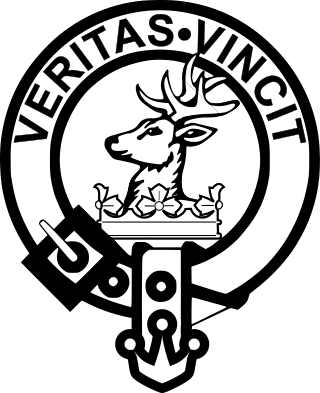
Clan Ross is a Highland Scottish clan. The original chiefs of the clan were the original Earls of Ross.

Clan Keith is a Highland and Lowland Scottish clan, whose Chief historically held the hereditary title of Marischal, then Great Marischal, then Earl Marischal of Scotland.

Clan Mackay is an ancient and once-powerful Highland Scottish clan from the far North of the Scottish Highlands, but with roots in the old Kingdom of Moray.

Clan Scott is a Scottish clan and is recognised as such by the Lord Lyon King of Arms. Historically the clan was based in the Scottish Borders.

Clan Gordon is a Highland Scottish clan, historically one of the most powerful Scottish clans. The Gordon lands once spanned a large territory across the Highlands. Presently, Gordon is seated at Aboyne Castle, Aberdeenshire. The Chief of the clan is the Earl of Huntly, later the Marquess of Huntly.

Clan Sutherland also known as House of Sutherland is a Highland Scottish clan whose traditional territory is the shire of Sutherland in the far north of Scotland. The chief of the clan was also the powerful Earl of Sutherland, however in the early 16th century this title passed through marriage to a younger son of the chief of Clan Gordon. The current chief is Alistair Sutherland who holds the title Earl of Sutherland.

Clan Boyd is a Scottish clan of the Scottish Lowlands and is recognized as such by the Lord Lyon King of Arms.

Clan Boyle is a Scottish clan of the Scottish Lowlands.

The origins of Clan MacCulloch are unknown, but there is a consensus that the family was one of the most ancient families of Galloway, Scotland, and a leading medieval family in that region. Despite the obscurity of the early history of the clan, the history and genealogies of the family are well documented in Walter Jameson McCulloch's History of the Galloway Families of McCulloch, which provides extensive footnotes for original Scottish charters, correspondence, and other primary source documentation. The latter provides family history for the following lines: Myretoun, Ardwell, Killasser, Torhouse, Drummorrell, Inshanks and Mule, Torhousekie, Cardiness, Barholm, Kirkclaugh, Auchengool, and Ardwall.

Clan Carmichael is a Scottish clan and is also considered a sept of the Clan Douglas, Clan MacDougall, Stewart of Appin, and Stewart of Galloway.

Clan Lennox is a Lowland Scottish clan. The clan chiefs were the original Earls of Lennox, although this title went via an heiress to other noble families in the fifteenth and sixteenth centuries. The chiefship of the clan then went to the Lennox of Woodehead branch.

Clan Cunningham is a Scottish clan. The traditional origins of the clan are placed in the 12th century. However, the first contemporary record of the clan chiefs is in the thirteenth century. The chiefs of the Clan Cunningham supported Robert the Bruce during the Wars of Scottish Independence. In the 15th and 16th centuries, the Clan Cunningham feuded with the Clan Montgomery. Historically, the chief of Clan Cunningham held the title of Earl of Glencairn. However, in modern times the chief of the clan is Cunningham of Corsehill. On 18 December 2013, Sir John Christopher Foggo Montgomery Cunninghame, Baronet of Corsehill, was recognized by Lord Lyon as Clan Chief after the chiefship had been vacant for over 200 years.

Clan Calder is a Highland Scottish clan. The clan is recognised by the Lord Lyon King of Arms but as it does not currently have a clan chief it is therefore considered an armigerous clan.

Clan MacDowall or MacDouall is a Lowlands Scottish clan.

Clan Oliphant is a Highland Scottish clan.

Clan Scrymgeour is a Highland Scottish clan.

Clan Matheson is a Highland Scottish clan.

Clan Swinton is a Scottish clan of the Scottish Lowlands.

Clan Cumming, also known as Clan Comyn, is a Scottish clan from the central Highlands that played a major role in the history of 13th-century Scotland and in the Wars of Scottish Independence. The Clan Comyn was once the most powerful family in 13th-century Scotland, until they were defeated in civil war by their rival to the Scottish throne, Robert the Bruce.

Clan Russell is a Scottish armigerous clan, with claimed origins in Normandy. It has ancestral ties to the English Dukes of Bedford, and has numerous descendants in Great Britain and America.





















